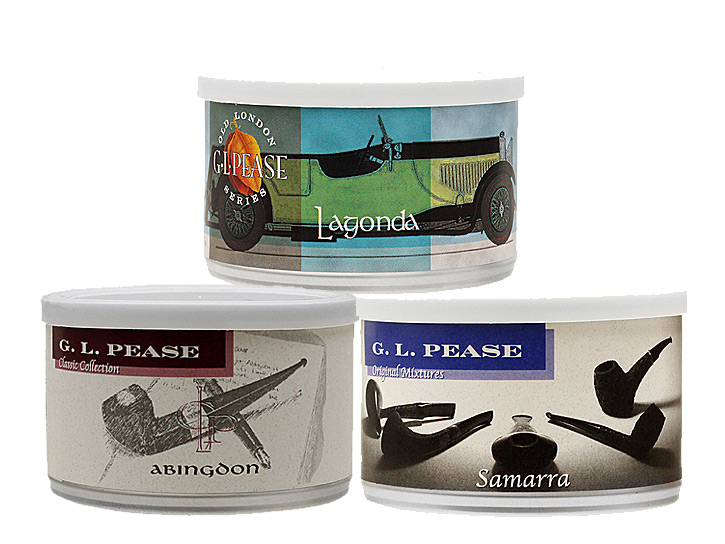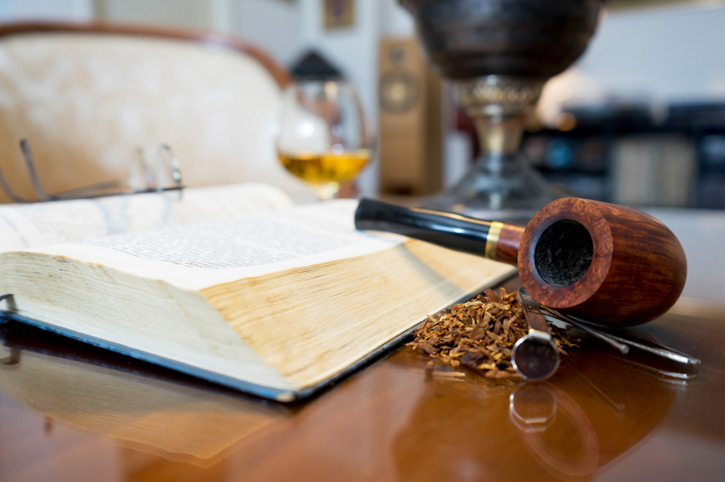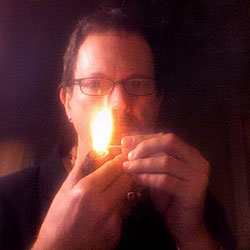G. L. Pease
 Some months back, I embarked on a little experiment, smoking three recently opened tins, and for reasons I can’t really explain (because I haven’t a clue), I alternated those three tobaccos in three different pipes. Despite the fact that I’ve always been a champion of seeking out those special pairings between a pipe and the tobaccos with which it performs best, I decided to try something different, and was a little surprised by the overall experience of this triple-triple-threat.
Some months back, I embarked on a little experiment, smoking three recently opened tins, and for reasons I can’t really explain (because I haven’t a clue), I alternated those three tobaccos in three different pipes. Despite the fact that I’ve always been a champion of seeking out those special pairings between a pipe and the tobaccos with which it performs best, I decided to try something different, and was a little surprised by the overall experience of this triple-triple-threat.
The tobaccos were all from my cellar, the fancy name for the stack of cardboard banker’s boxes that are filled with tins of aged or aging leaf, and were chosen by the whim of the day. I pulled out a 10 year old tin of Samarra, a five year old Abingdon, and a Lagonda that was less than a year old. At the point of manufacture, these three mixtures, though sharing many of the same ingredients, are distinct from one another. Lagonda is full, rich, slightly sweet; Abingdon is more direct, classically styled, dry and creamy; Samarra is a bit lighter, but more complex, exotic, and intriguing from the contribution of that wee bit of perique. When the influence of age is added into the picture, things become more interesting. Ten years have treated the Samarra really well. I remember going a little starry over a six year old tin a few years ago, but those extra four have just amplified the magic, turning the knob up to eleven. The younger Lagonda is just that; youthful, exuberant, still evolving. I love this mixture, and have always fount it a nice balance between the dark and light tobaccos. It fits wonderfully into that nebulous zone between medium and full, sometimes expressing itself a little more in one direction than the other.
The Abingdon, though, caught me off guard when I pulled the top. Some may have caught the hints of the inspiration behind this one when I’ve written about it in the past, but for the rest of you, here’s the back story. When I began to think about what I wanted to do with the Classic Collection, I had it in mind to pay tribute to some of the tobaccos of the past that had inspired me over the years—not to attempt their recreation, which is always something of a fool’s errand, but to produce blends that were reminiscent of what certain blends meant to me.

Blackpoint, for instance, was inspired by a friend’s opening and sharing with me of a dusty old 4oz tin of Balkan Sobranie 759. I included a little perique in my homage because that specific tin, freshly opened, offered up an aroma, a taste of something that reminded me of the stewed-fruitiness of Louisiana’s finest. Blackpoint was never meant to evoke the broader sense of 759, at least the 759 I smoked in the very early 1980s, (and I smoked a lot of it), but I wanted to catch just a spark of that single experience in a new mixture.
There were a handful of tobaccos that really captured my head and my heart in the earliest days of my pipe smoking: Garfinkel’s Orient Express #11, Dunhill’s London Mixture, Ardath’s State Express, the Celebrated Bengal Slices out of Sobranie House, and of course, their 759, which I preferred as a tie to the original "Smoking Mixture". There were others, of course, but I always had a tin of at least one of these staples open, and could rely on any of them for a great smoke.
It was my desire to paint something of a leaky memory picture of what the now old 759 was like in its relative youth that inspired me to concoct Abingdon. Pulling the lid off this tin a few years later, I was actually a bit surprised to find that the arrow may have landed a little closer to its target than I’d hoped. It made an ideal compliment to the other two for my exploration.
What about the pipes?
The first was one of the Pease/Di Piazza June Bugs, brought to life by Radice, this in a lovely brown Rind (rusticated) finish. I’d only smoked this one a couple of times. Second up, a beautiful 1985 Ashton sandblasted lovat that I’ve owned since it was new, but have rarely smoked, and it retains much of its newness. Third, a relatively recently acquired Castello Sea Rock #10, a gift from a friend, that I’d begun breaking in using the "By Thirds" method, putting fewer than a dozen bowls through it, but, for unknown reasons, then put in the rack where it sat, ignored. So, none of the pipes had yet been well seasoned, and since I’ve been on something of a mission over the past year or so to become better acquainted with the pipes that haven’t gotten enough love, I looked forward to spending some quality time with these three.
The idea was simple enough. Three tobaccos, three pipes, nine combinations. The results were interesting, though not completely unexpected. I’ve always held tightly the notion that every pipe has its own personality, and will bring out different nuances of the tobaccos we burn in them, and this exploration certainly bore that familiar fruit. There’s a particular high-sugar red virginia in Samarra, for instance, that when smoked in the Radice, plays its role too dramatically, to the point where I actually found it overbearing. The Ashton, despite having a similar chamber geometry, was deeper, darker tasting, delivering a beautifully balanced flavor to the same mixture. The tables turned with the Abingdon, though. which almost seemed too dark in the Ashton, but delightfully nuanced and luxurious in the June Bug.

The Castello was a bit of an outlier. Normally, I think of the Castello signature taste, at least when not fully broken in, to be bright and sweet, almost strident, resulting in my tending to get them out of the gate with heavier blends. This one, though, was different. From the first bowl, its smoke was smooth and polished, not emphasizing any one aspect of the tobacco. It turned out to be an ideal companion to the other two on this journey, tasting great with both the Samarra and the Abingdon. Three pipes expressing two different tobaccos in distinctly unique ways. What about the newer Lagonda?
Here’s a blend that I find to be generally very forgiving. It’s one that’s not as sensitive to different pipes as the other two, so I expected a little more sameness between the three pipes, and after several bowls in each, that’s exactly what I got. The differences were still there, but they weren’t nearly as pronounced as they were with the other tobaccos.
Ah, the sweet mysteries of the briar. Each of these pipes turned out to be fine smokers, and each continued to exhibit their peculiarities in personality throughout the experiment. But, what’s the point of all of this? Simply that getting to know a tobacco or a pipe can have more to do with the interplay between fuel and vessel than we might reasonably expect, and that sometimes it’s just fun to play. That I got the opportunity to turn three somewhat neglected briars into favored companions is an added benefit. In the end, the Radice became my choice for Abingdon, the Ashton for Samarra, and the Castello absolutely sings with Lagonda.
Next time a pipe or a tobacco gives you grief, instead of putting it aside, change things up, and see if another combination might offer some hint of magic. Just don’t give up too soon. Do your own Three by Three experiment. Sometimes new friends are found in surprising places.
Your turn.
-glp
 Since 1999, Gregory L. Pease has been the principal alchemist behind the blends of G.L. Pease Artisanal Tobaccos. He’s been a passionate pipeman since his university days, having cut his pipe teeth at the now extinct Drucquer & Sons Tobacconist in Berkeley, California. Greg is also author of The Briar & Leaf Chronicles, a photographer, recovering computer scientist, sometimes chef, and creator of The Epicure’s Asylum. See our interview with G. L. Pease here. |
















I have tried matching up tobacco’s with a particular pipe for years without really realizing it. I have my favorite combinations of pipe and tobacco with what I’m drinking also, like coffee, ice tea, beer or single malt, but I have trouble remembering most of the time. I’d give anything if I’d have started a pipe and tobacco log years ago.
I have Samarra in my cellar. I know that you used the three tobacco’s in your article only as examples, but after reading the reviews for Lagonda and Abingdon, I’ll just have to order some…! Thanks for the great read!
A bit before your time Greg but the original circa 1968 USA packaging for State Express was unique in that included a British shilling to open the tin. Back then, like you, we referred to it as State Express but its actual name was Ardath’s STATE EXPRESS London Mixture to distinguish it from Ardath cigarette products which carried the State Express trademark. Like Dunhill, Ardath had a Royal Warrant but only for cigarettes.
Generally speaking I just sort my pipes out into “English” only or VA/VaPer only. I do have a couple of pipes that just cry out to be used with one tobacco only.
3 x 3 may be a workable starting point but it doesn’t begin to map the terrain.
.
Pairing about 40 pipes with dozens of jarred blends in the active rotation requires nothing less than a multi-page spreadsheet. Different blends are listed down the page rows, with the columns assigned to the successive smokes in the pipe to which that page is devoted.
.
In the simplest case, the enjoyment level of the smoke is rated from 1 to 5, though more complicated schemes are possible using sub-columns to rate different aspects of the smoke.
.
Anal retentive as I am, I cannot see myself actually doing this. I just plod through the endless combinations taking great delight on those occasions when I am blind-sided by the occasional transcendent smoke; which, most of the time, cannot be reproduced anyway.
Man I have certain pipes that I smoke certain types of tobacco in. I have played with the idea of trying tobaccos that I am not crazy about in a different pipe. As a matter of fact I have…. BUT. My ‘nicer’ pipes get burley flakes and things like University and Irish Flake and JackKnife, and you know, bolder type stuff that will almost put one to sleep. I have a 70’s Charatan second Canadian that I, about a year ago decided to smoke only Latakia blends in and man that old briar is AWESOME! I have a half dozen old Grabows form a fiend who’s deceased and wife gave me his pipe stuff. He stopped smoking in ’73. For OTC pipes they are unbeatable so far. Well dried out they all smoke like a dream. WOW who’d a thunk it?! These hombres take anything very well. VA’s Vapers, Lat blends, and especially ol’ Carter Hall. Still I have a really hard time integrating my ‘nicer’ somewhat dedicated pipes to other stuff.
I mean hey, I’d have to buy a few more pipes if I did that?! Come to think about it, any excuse will do. But to change up Castello, Tsuge, and some nice Luciano’s Nah, not ready yet unless you have a way to persuade me Greg.
Naturally, the terrain becomes increasingly difficult to map as the variables increase, Cortez, so, yes, this is just a starting point. More, it’s a fun and easily accessible experiment to examine just how much difference there can be, even when limiting the variables to a manageable number. Would I routinely do things this way? Not likely, but I’m glad I did it once.
.
And, Jon, I don’t recall SELM coming with the coin, but I do remember having old tins with the small, whole leaf of smyrna on top of the packed ribbon. That was a really nice touch. Ardath’s marketing approach came directly from their cigarette division, where things like that were once common. It’s sad they discontinued it.
The addition of the Shilling was discontinued early on Greg, but I think SELM still included the complete Turkish leaf throughout its production, although the way it was presented within the tin may have changed.
Jon, the whole leaf disappeared sometime in the 1970s. By the time I was buying the stuff off the shelves in the early 1980s through its discontinuation, it was already gone, but I have had many an earlier tin that had the leaf. It was really a nice touch. I’ve still got several tins left in the cellar. MIght be time to pop one open!
MANY thanks for the correction Greg! That means the SELM tin I opened a couple years ago (with its weight in grams vs. ounces) must have been older than I thought. By 1990 SELM was no longer available to me from my usual sources. Any thoughts as to when it was actually discontinued?
Jon, a friend of mine reports buying the last tin he could find on a tobacconist’s shelf in 1998, and that it likely been sitting there for a long while. The trademark registration appears to have expired at the end of 1992, which is at least a bit of a clue, but I don’t know how much earlier the brand “expired.”
I have always dedicated specific “or Similar” tobacco blends to specific pipes. I have found, over the years, that sometimes specific pipes are “better” with specific blends. For example, I have a very old-aged briar pipe that has its own character. It is not ghosted at all. But, this pipe is a natural for Virginia specific blends like no other pipe. So, I agree with G. L. Pease. Experiment intelligently. You may have a hidden surprise!
____________________________________________________________________________________
[URL=http://s395.photobucket.com/user/CaptainBob2008/media/003-016-01781_zpsd9076106.jpg.html][IMG]http://i395.photobucket.com/albums/pp36/CaptainBob2008/th_003-016-01781_zpsd9076106.jpg[/IMG][/URL]
I knew the BS#759 versions were reprised by Abingdon and Blackpoint Greg but would you be prepared to reveal which other old time blends you were commemorating in the Classic Collection?
I mean, of course, which of your blends reprised the Orient Express, Ardath etc. (as well as which other original blends).
My guesses are these. Charing Cross, inspired by Balkan Sobranie White. Kensington, inspired by Ardath’s State Express London Mixture. Piccadilly, inspired by Benson & Hedges’s Finest Smoking Mixture, which was produced by Gallahers. Stratford, inspired by Dunhill’s Elizabethan Mixture.
I’m positive about Piccadilly, pretty confident about Kensington and Stratford, and making a total guess about Charing Cross.
Tried Abingdon (but only 2 1/2 years old) in my June Bug and got a noticeably different taste to the Peter Heeschen I had been smoking it in. The first smoke after cleaning with vodka (I had been giving Key Largo a go in it) was sublime but after that the June Bug accentuated the zingy dry taste making the tobacco seem younger. So interesting, but I think the Junebug is destined to go back to being a star of my top tobacco (Robusto) rotation. May try Abingdon in some other pipes (large Dunhill perhaps) but I think with Abingdon it is an age thing like the great clarets it so resembles; a bit fierce but well structured in youth but sublime in depth and structure in their prime. I hope it does not get too much like 759; my admittedly no doubt fallible memory of two tins of that in the 1980s was a smooth complex smoke that broke campari bitter about 3/4 way down the bowl. When I raised this at the Sobranie store (then at the Vigo end of Burlington Arcade) the response was loud, and quite rude, denial that a Sobranie tobacco could possibly be bitter. I can’t remember when in the 1980s this was so it may have been a fair way down Sobranie’s sad journey with Gallaher and I can’t help wondering if Burley caused the problem (it certainly was’nt a ghosting problem as it disappeared with the next tobacco). As to the customer relations Dunhill’s Jermyn Street store was just as bad at the beginning of the 1980s but completely changed when the late and much lamented Charles Elliott took over to be succeeded by the equally great Marc Burrows.
Any chance of any further June Bug production – it seems sad that only 100 of such a fine design were made?
Regards
Ed T
Let me don my “slow” hat before writing more, using it as a dodge from being bombarded with clods of dirt for not being able to find these nuanced perceptions as regards pipe and tobacco pairings. I just don’t notice them but probably could with some study.